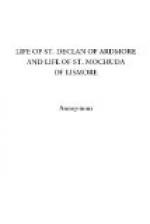Against Theory of Early Fifth Century period.
I.—Contradictions, anachronisms, &c., of
Life.
II.—Lack of allusion to Declan in the Lives
of St. Patrick.
III.—Prosper’s testimony to the mission
of Palladius as first bishop to
the believing Scots.
IV.—Alleged motives for later invention
of Pre-Patrician story.
In this matter and at this hour it is hardly worth appealing to the authority of Lanigan and the scholars of the past. Much evidence not available in Lanigan’s day is now at the service of scholars. We are to look rather at the reasoning of Colgan, Ussher, and Lanigan than to the mere weight of their names.
Referring in order to our tabulated grounds of argument, pro and con, and taking the pro arguments first, we may (I.) discard as evidence for our purpose the Life of St. Ibar which is very fragmentary and otherwise a rather unsatisfactory document. The Lives of Ailbhe, Ciaran, and Declan are however mutually corroborative and consistent. The Roman visit and the alleged tutelage under Hilarius are probably embellishments; they look like inventions to explain something and they may contain more than a kernel of truth. At any rate they are matters requiring further investigation and elucidation. In this connection it may be useful to recall that the Life (Latin) of St. Ciaran has been attributed by Colgan to Evinus the disciple and panegyrist of St. Patrick.
Patrick’s apparent neglect of the Decies (II.) may have no special significance. At best it is but negative evidence: taken, however, in connection with (I.) and its consectaria it is suggestive. We can hardly help speculating why the apostle—passing as it were by its front door—should have given the go-bye to a region so important as the Munster Decies. Perhaps he sent preachers into it; perhaps there was no special necessity for a formal mission, as the faith had already found entrance. It is a little noteworthy too that we do not find St. Patrick’s name surviving in any ecclesiastical connection with the Decies, if we except Patrick’s Well, near Clonmel, and this Well is within a mile or so of the territorial frontier. Moreover the southern portion of the present Tipperary County had been ceded by Aengus to the Deisi, only just previous to Patrick’s advent, and had hardly yet had sufficient time to become absorbed. The whole story of Declan’s alleged relations with Patrick undoubtedly suggests some irregularity in Declan’s mission—an irregularity which was capable of rectification through Patrick and which de facto was finally so rectified.




